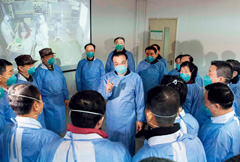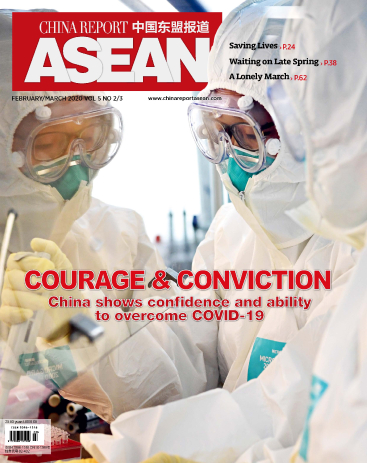On February 24, press conference of WHO-China Joint Mission on COVID-19 was held in Beijing. The joint expert team consisting of experts from China and the World Health Organization said China's unprecedented public health responses to the COVID-19 outbreak have yielded notable results in blocking human-to-human transmission of the virus, preventing or at least delaying hundreds of thousands of cases.
The assessment was given after the 25-member team conducted a nine-day field study trip in China's Beijing, Guangdong, Sichuan and Hubei.
China has also played a critical role in protecting the international community, buying precious time for countries to adopt active prevention and control measures and providing them with worthwhile experience, the team said.
Beijing has been on high alert since the early days and activated the public health emergency response mechanism as soon as confirmed cases rose to 200. On January 20, President Xi Jinping and Premier Li Keqiang instructed governments at all levels to pay highest attention to the development of the epidemic. The National Health Commission and local authorities were ordered to activate allround emergency response mechanisms.
On January 25, Premier Li was designated head of the CPC Central Committee leading group on novel coronavirus prevention and control, and two days later he visited Wuhan to inspect the latest progress. The Chinese government has effectively coordinated medical supplies and sent experts to Wuhan to save more lives.
Strong Support from Government
On January 27, Premier Li arrived in Wuhan in an inspection trip. He offered medical workers and residents battling the COVID-19 outbreak in Wuhan a morale boost, pledging the nation's all-out support to the epicenter of the outbreak.
He encouraged the medical workers to forge ahead and seize every minute in the pressing task of saving the infected during a critical period for epidemic prevention and control.
After learning of an even starker shortage of nurses in the city than doctors, he said the country would send more medical workers to support the city and medical supplies such as masks and safety goggles would arrive soon. Multiple measures would be adopted to ensure the city's daily supply of protection suits, he added.
Li also sought to boost the morale of workers on the construction site for Huoshenshan Hospital, an emergency medical facility dedicated to the outbreak. He asked the manager of the project about the difficulties being faced and materials that were still lacking, saying that meeting those requests would be the government's priority.
Rapid mobilization at the top level catapulted the whole nation into instant reaction. As of February 20, more than 32,500 medical staff of 255 medical teams from all over the country had arrived in Wuhan and other places in Hubei. Medical supplies including face masks, protective suits, and medicines also arrived in epidemic areas. The Ministry of Industry and Information Technology urged medical suppliers across China to restore to their full productive capacity to ensure sustained provision of all necessary items. The Ministry of Finance allocated 1 billion yuan (US$140 million) in emergency funds for Wuhan and Hubei. Vegetables, food, and other life necessities have been sent from other places to Wuhan for the 9 million residents there. Strong support of the government has guaranteed the victory of the war against COVID-19.
Expert Teams in Wuhan
In the battle against COVID-19, research and development of medicines for the disease is very crucial. On January 20, two academicians were invited to the State Council's executive meeting to advise on the prevention and control of the novel coronavirus-related pneumonia.
Zhong Nanshan, a renowned respiratory expert, offered specific suggestions on how to curb the spread of the epidemic, and Li Lanjuan, an expert in infectious diseases, gave her suggestions on how to strengthen the prevention, control and treatment of the epidemic.
“The reason we invited the two experts today is to study and define the epidemic from a scientific perspective, in order to prevent and respond to it in a more effective way,” Premier Li Keqiang said at the meeting, “The professional advice provided by the two experts is very important for us to make scientific decisions in the next step.”
Clearly, China has mobilized the country's largest and strongest medical force to combat the novel coronavirus pneumonia epidemic. So far, three teams, led by academicians Zhong Nanshan, Wang Chen and Li Lanjuan, have been helping Wuhan and the rest of the country by strengthening consultation and treatment of critical patients. The three teams are also exploring new drugs and therapies to devise effective methods to guide nationwide medical treatment.
National Health Commission had also sent high-end medical equipment as well as medical professionals from its affiliated hospitals, including the strongest ones in critical care.
Three mobile polymerase chain reaction laboratories were also sent to Wuhan to improve testing, while 22 national emergency medical rescue teams were also deployed to help treat the patients in mobile cabin hospitals, according to National Health Commission official Guo Yanhong on February 13.
Apart from Wuhan, 16 other cities in Hubei also hit by the epidemic have received pairing assistance from 19 provinces, including Jiangsu, Guangdong, Shandong and Zhejiang.
Besides, foreign experts also arrived in China to help curb COVID-19. On February 5, five Russian epidemic prevention experts went to Wuhan to work together with Chinese peers on researching vaccines and test kits for the novel coronavirus. Five days later, virus test kits developed by the Russian experts passed assessment. The test kits can be preserved at a temperature of 4 degrees Celsius, while similar test kits developed by other countries need to be preserved at minus 20 degrees Celsius. The testing is easy to do, with only smear samples from nose and pharynx required to be collected, and the test outcome can be seen in four hours. The scientists of the two countries are now working on co-developing vaccines for the virus.
On February 10, the WHO also sent a team of international experts to China to work with Chinese experts. The WHO team is led by Bruce Aylward, a veteran of past public health emergencies. The experts were commissioned to help China trace the virus and provide suggestions on quarantine. They visited Beijing and three provinces to learn about the effectiveness of the epidemic prevention and control measures in urban and rural areas of China.
Aylward praised China's efforts on the press conference on February 24. “This approach of all-of-government and all-of-society is very old-fashioned and has averted and probably prevented at least tens of thousands, even hundreds of thousands, of cases,” he said. “It is extraordinary.”
Aylward said he recalled from the trip in China one particularly striking fact: In Wuhan, the epicenter of the outbreak and under a severe medical strain, hospitals' beds are opening up and medical institutions have the capacity and space to receive and care for all patients for the first time in the outbreak.
“To the people of Wuhan, it is recognized that the world is in your debt. When this disease finishes, hopefully we will have a chance to thank the people of Wuhan for the role they have played,” he declared.

Chinese Premier Li Keqiang talks with doctors at a hospital in Wuhan, Hubei Province, the epicenter of the novel coronavirus outbreak, during an inspection tour on January 27.


 Copy Reference
Copy Reference